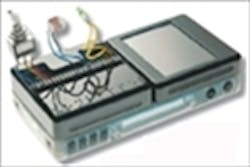My latest prototype is a four-month project to turn a pack of pachysandra into grass. Taking the organic route, I mowed down the pachysandra and ivy, cleared off the mess, layered on newspapers and cardboard, added some shredded paper and leaves, and topped it with a hefty layer of Earthmate compost, about 6 yards worth.
This should kill everything while creating a good base to plant grass. It’s a process that many have used over the years, so there isn’t much risk here. On the other hand, there can be significant risk in building a prototype for the module device market or just about any other technology product area.
I recently spoke with Peter Semmelhack of Buglabs about prototypes and his company’s BUGbase platform (Fig. 1). In fact, the title of this article is a quote from a Buglabs customer, referring to the typical approach to prototypes at a particular company. It has a nice ring to it, but it’s the thought that counts—and the price. It isn’t far off in many instances.
This high cost often translates into high risk. It also leads to a problem that Peter highlighted: failure is not an option. This is fine for production, but prototypes should be throwaways. They are designed to provide information, even negative information. They are experiments.
Experimentation is where modules and products like BUGbase come into play. It’s not a new approach, but it’s much easier now than in the past as the myriad new modules in this section attest. It is also a mindset that engineers and scientists are brought up with that’s often counter to what VPs and marketing managers want.
Buglabs started out with some interesting goals, including making an opensource platform from the software to the hardware. As it turns out, most of its sales are going to corporate entities building prototypes or small production runs. The open nature of BUGbase makes it easy to add a custom module at significantly lower cost and risk than a completely unique prototype.
I also spoke with Stephen Newbegin of Acces I/O Products about USB and its effect on prototypes because of the ease with which USB connects to almost any platform. Boards like the Acces I/O USB-DIO-48 with 48 digital I/O ports work equally well with a laptop for prototyping or in a production embedded system (Fig. 2). The PC/104 form factor is one of many supported by Access I/O. The company also offers a tiny USB-based I/O board that plugs into VIA’s Pico-ITXe board.
So take advantage of modules. If you don’t, your competition will.
ACCES I/O PRODUCTSwww.accesio.comBUGLABSwww.buglabs.comAbout the Author
William G. Wong
Senior Content Director - Electronic Design and Microwaves & RF
I am Editor of Electronic Design focusing on embedded, software, and systems. As Senior Content Director, I also manage Microwaves & RF and I work with a great team of editors to provide engineers, programmers, developers and technical managers with interesting and useful articles and videos on a regular basis. Check out our free newsletters to see the latest content.
You can send press releases for new products for possible coverage on the website. I am also interested in receiving contributed articles for publishing on our website. Use our template and send to me along with a signed release form.
Check out my blog, AltEmbedded on Electronic Design, as well as his latest articles on this site that are listed below.
You can visit my social media via these links:
- AltEmbedded on Electronic Design
- Bill Wong on Facebook
- @AltEmbedded on Twitter
- Bill Wong on LinkedIn
I earned a Bachelor of Electrical Engineering at the Georgia Institute of Technology and a Masters in Computer Science from Rutgers University. I still do a bit of programming using everything from C and C++ to Rust and Ada/SPARK. I do a bit of PHP programming for Drupal websites. I have posted a few Drupal modules.
I still get a hand on software and electronic hardware. Some of this can be found on our Kit Close-Up video series. You can also see me on many of our TechXchange Talk videos. I am interested in a range of projects from robotics to artificial intelligence.

